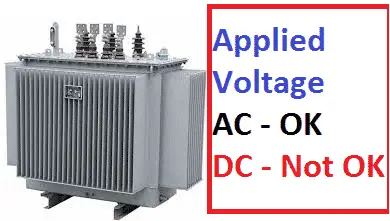This article describes why DC is not used in transformers. The transformer functions on the principle of Faraday’s Law of electromagnetic induction. When AC is applied to the primary of the transformer, EMF is induced in the primary, which opposes the voltage.

The back EMF induced in the primary is;
Ep = – Np dΦ/dt
Ep = 4.44 Φ f Tph
The flux produced in the primary gets linked to the secondary turns of the Transformer, and voltage is induced in the secondary.
If DC is fed to the transformer, the voltage induced in the primary is;
Ep = – Np dΦ/dt
Rate of change of flux in case of the DC is zero. Therefore,
Ep = – Np dΦ/dt
Ep = – Np x 0
Ep = 0
The current flowing in the primary is;
Ip = (Vp- Ep)/ Zp
Ep = 0 [ In case of DC ]
Ip = (Vp- 0)/ Zp
Ip = Vp/ Zp
The impedance of the primary winding in case of DC supply is applied to the primary is;
Zp =√ ( R2p + X2p)
Where, Xp = 2 πf Lp
In the case of DC supply, f=0
Xp = 2 πf Lp
Xp = 2 πx 0 xLp
Xp =0
Therefore,
Zp =√ ( R2p + X2p)
Zp =√ ( R2p + 0)
Zp =√ R2p
Zp =Rp
The current flowing through the primary of the transformer is;
Ip = Vp/ Rp
If DC voltage is applied to the transformer’s primary winding, the current through the winding will be very high. The following are the reasons for the high current flowing in the primary.
The back EMF(Ep) induced in the primary is zero; therefore, there is no limiting back EMF in the primary of the transformer. The second reason is that the coil of the primary does not have impedance; rather, it has resistance only. The resistance of the primary winding is very low. Therefore, the large current flows through the primary, and the winding gets overheated, resulting in insulation failure, which leads to a short circuit.
Therefore, the DC supply should not be fed to the transformer for its operation.